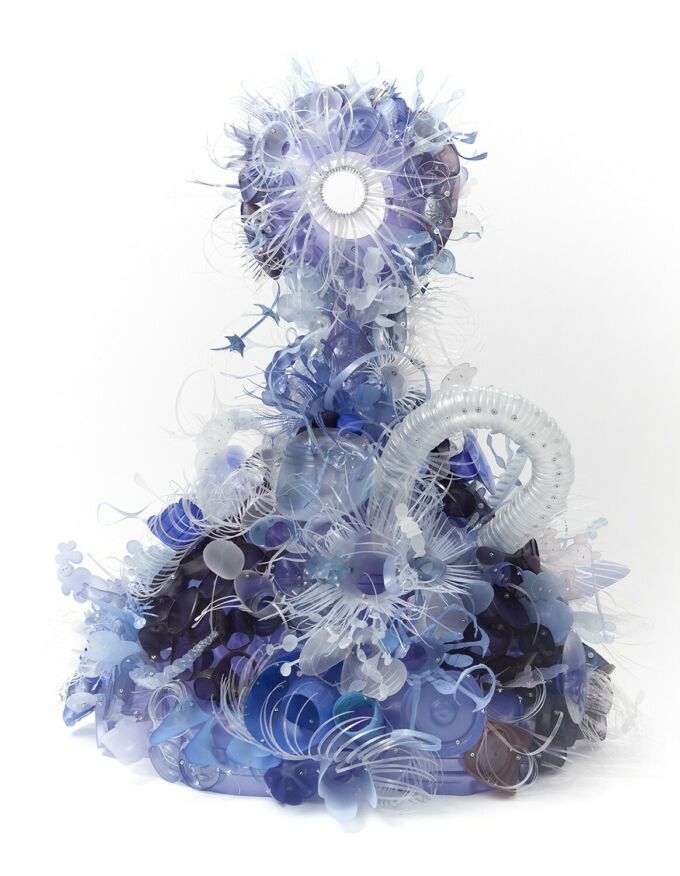October 01, 2019
'Plastic Entanglements' to at Palmer Museum of Art

Sixty works exploring the complex story of plastic‚ from drawings and photographs to video installations and sculptures fabricated from found plastic‚ will be featured in Plastic Entanglements: Ecology, Aesthetics, Materials, on view at the Palmer Museum of Art at Penn State, February 13 through June 17, 2018.
Organized by the Palmer Museum of Art, this major loan exhibition includes work by 30 emerging and mid-career contemporary artists from around the globe, such as Mark Dion, Marina Zurkow, Zanele Muholi, Vik Muniz, Jessica Stockholder, Chris Jordan, Brian Jungen, Aurora Robson, Willie Cole, Pinar Yoldas, Tejal Shah, and Moreshin Allahyari. The artists' work examines the environmental, aesthetic, and technological implications of plastic and how it infiltrates virtually every aspect of our lives.
"This groundbreaking exhibition charts new territory for the Palmer Museum as we extend our interdisciplinary reach and impact," stated Erin Coe director of the Palmer Museum of Art. "The exhibition highlights issues that concern us all and every audience member‚ preschoolers, college students, and art historians alike‚ will leave the exhibition with a new understanding of a material that we use every day: plastic."
Plastic Entanglements unfolds in three sections, charting a timeline‚ past, present, and future‚ of our relationship with plastic.
"The Archive" examines the ways in which plastic objects make up an inadvertent record of daily life from the mid-20th century onwards.
"The Entangled Present" reveals the ways in which plastic binds people, plants, and animals together across diverse geographical locations and through global systems. The works of art in this section focus attention on the complex effects of the reach of plastic on ecological networks as well as on current artistic practice.
The exhibition concludes with a section dedicated to "Speculative Futures," asking what unknown worlds are emerging from the omnipresence of plastic, including new geologic and biologic forms.
Plastic Entanglements: Ecology, Aesthetics, Materials was curated by Joyce Robinson, curator at the Palmer Museum of Art; Jennifer Wagner-Lawlor, professor of women's, gender, and sexuality studies and English at Penn State; and Heather Davis, independent scholar.
"Part of the excitement around Plastic Entanglements will emerge from the fact that plastic is ubiquitous," states Robinson. "Those who might be intimidated by a 'contemporary art' exhibition will find themselves immediately drawn in by the familiarity of plastic, which actually makes the world we live in possible."
Wagner-Lawlor adds, "We hope the exhibition offers viewers a new perspective‚ more than one, actually‚ on a material so common that we don't think about where it comes from, how we use it, how it is impacting the environment, local and global ecologies, and even our own health. The exhibition explores different sides of our lives with plastic, balancing the ecological concerns many artists bring to their work, with their simultaneous appreciation of the versatile material properties of plastic."
The exhibition will travel to the Jordan Schnitzer Museum of Art, University of Oregon (September 22–December 30, 2018); Smith College Museum of Art (February 8–July 28, 2019); and the Chazen Museum of Art, University of Wisconsin-Madison (September 13, 2019–January 5, 2020).
This exhibition was made possible by available funds from the Donald W. Hamer Endowment for Art Acquisitions and Exhibitions. Major support was provided by The Arboretum at Penn State, College of Arts and Architecture, Materials Research Institute, Sustainability Institute, University Libraries, George Dewey and Mary J. Krumrine Endowment, Pennsylvania Council on the Arts, and the National Endowment for the Arts, in addition to funding from 25 other entities across campus.
Programming associated with the exhibition includes gallery talks, lectures by participating artists, films, and conversations with scholars whose work addresses plastic in some way.
IMAGE: Aurora Robson, Isla, 2014, plastic debris (PET + HDPE), aluminum rivets, tinted polycrylic, and mica powder. Courtesy of the artist.
Institute for invertebrate marine biology, 2017, wood cabinet, plastic and rubber children's toys, sex toys, glass specie jars, and books
Courtesy of the artist and Tanya Bonakdar Gallery, New York.
